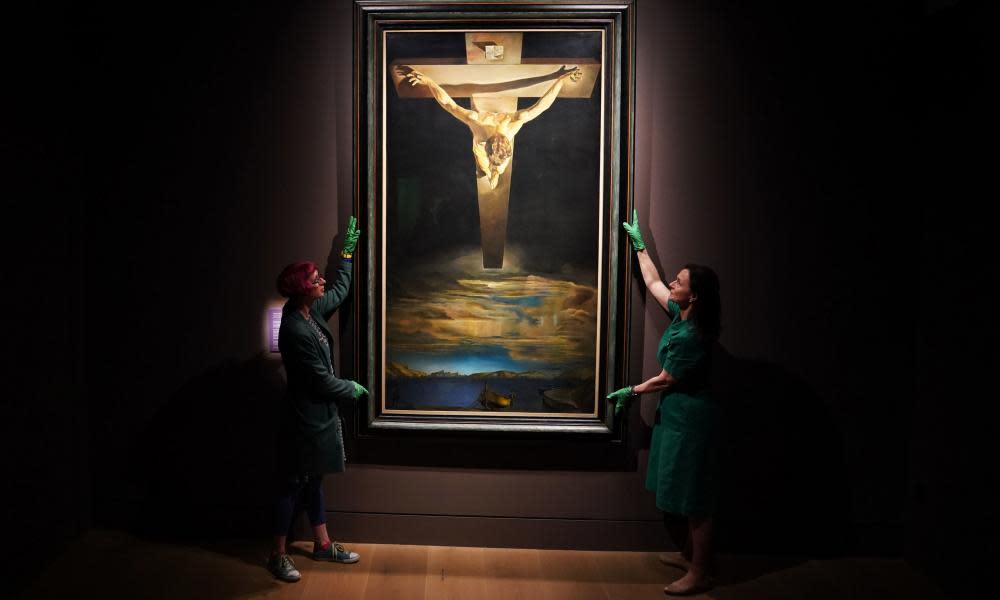Spanish masterpieces united in Bishop Auckland’s ‘Prado of the north’

Two towering examples of Spanish religious art, separated by 350 years but with as many parallels as contrasts, have been brought together in the unlikely setting of a “left behind” post-industrial market town in north-east England.
The Spanish Gallery in Bishop Auckland is fast becoming something of a “Prado of the north”, some say, and while that might be a slight exaggeration there is certainly art on display there the likes of which cannot be seen anywhere else but the Madrid gallery.
This weekend visitors will be able to see two devotional masterpieces together for the first time: Salvador Dalí’s much reproduced Christ of St John of the Cross, painted in 1951, alongside El Greco’s Christ on the Cross, which dates from the first decade of the 17th century.
“It is quite a stunner isn’t it,” said the curator Morlin Ellis in front of the Dalí painting. “It affects people in so many ways. I’ve known this painting since I was eight years old because a copy used to be on the stairs of our GP’s house. This is the first time I’ve seen it in person.”
The Dalí is a superstar of the Kelvingrove art gallery in Glasgow, cannily acquired in 1952 by the then director, Tom Honeyman. It can now lay claim “to be one of the most celebrated images of the 20th century,” said Ellis.
Duncan Dornan, the head of museums and collections in Glasgow, said displaying “this treasured painting in a new way enables us to widen our understanding of the incredible artist. It will go back on show at Kelvingrove early in 2023.”
The Dalí goes on display next to an El Greco bought by the Spanish Gallery’s funder, Jonathan Ruffer, back in 2015. It shows the moment in St Matthew’s gospel when Christ looks up and says: “My God, my God, why have you forsaken me?”
Side by side the similarities and the contrasts between the paintings soon become clear. El Greco’s work drips with blood; he wants the viewer to feel Christ’s pain. Dalí’s Christ has no nails, no blood; the artist wants to elevate the nobility of the crucifixion.
The two artists may have been 350 years apart but they have much in common, curators argue. They are two of the most original and idiosyncratic of any artist in western art history, said Ellis, and they “both had an insatiable desire for knowledge in all areas”.
She hopes the display will provoke lively discussion between visitors.
Bishop Auckland’s Spanish Gallery was opened last year by Prince Charles and the Queen of Spain. Its displays have been bolstered by generous loans including two Murillo works – one from Woburn Abbey and the other, Three Boys, from the Dulwich Picture Gallery.
The collection has three works by Juan Bautista Maíno, not a household name but incredibly important, said Ruffer. “He is the link between Caravaggio and Velázquez. He was painter to the king.”
Ruffer is a self-confessed “city slicker”, a millionaire financier who wanted to come back to his north-east England roots and help regenerate Bishop Auckland.
The journey started because remarkable Zurburán paintings that have hung in Auckland Castle since 1756 were 20 years ago being sold by church commissioners.
Ruffer’s £15m interjection stopped that, and so began a wider cultural regeneration project including restoration of the castle and its opening as a tourist destination; and the opening of a mining art gallery, the Spanish Gallery, a deer park and Kynren, which uses a 3 hectare (7.5 acre) stage for London Olympics-style live shows telling Britain’s history.
Bishop Auckland, like many northern towns since the closure of the mines, is a place that has seen better days. But it has so much going for it, Ruffer said, and the loan of the Dalí from Glasgow is an important milestone in the regeneration journey.
“It puts the cat in catalyst,” joked Ruffer, “as well as among the pigeons.”

 Yahoo Movies
Yahoo Movies 
